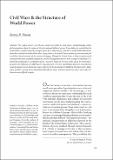Civil Wars & the Structure of World Power
Author(s)
Posen, Barry R
Downloaddaed_a_00467.pdf (394.8Kb)
PUBLISHER_POLICY
Publisher Policy
Article is made available in accordance with the publisher's policy and may be subject to US copyright law. Please refer to the publisher's site for terms of use.
Terms of use
Metadata
Show full item recordAbstract
The “policy science” of civil wars, which emerged in the early 1990s, included deeply embedded assumptions about the nature of the international political system. It was taken for granted that the United States would remain the strongest power by a wide margin, and that it would lead a liberal coalition that included virtually all the other strong states in the world. Some students of international politics believe that the nature of the system is changing. Though the United States is likely to remain much more powerful than its global competitors, several consequential powers have emerged to challenge U.S. leadership and produce a multipolar system. As power begins to even out at the top of the international system, the influence of middle powers may also grow. This new constellation of power seems likely to magnify disagreements about how states suffering civil wars should be stabilized, limit preventive diplomacy, produce external intervention that will make for longer and more destructive wars, and render settlements more difficult to police.
Date issued
2017-09Department
Massachusetts Institute of Technology. Department of Political ScienceJournal
Daedalus
Publisher
MIT Press
Citation
Posen, Barry R. “Civil Wars & the Structure of World Power.” Daedalus 146, 4 (October 2017): 167–179 © 2017 Barry R. Posen
Version: Final published version
ISSN
0011-5266
1548-6192